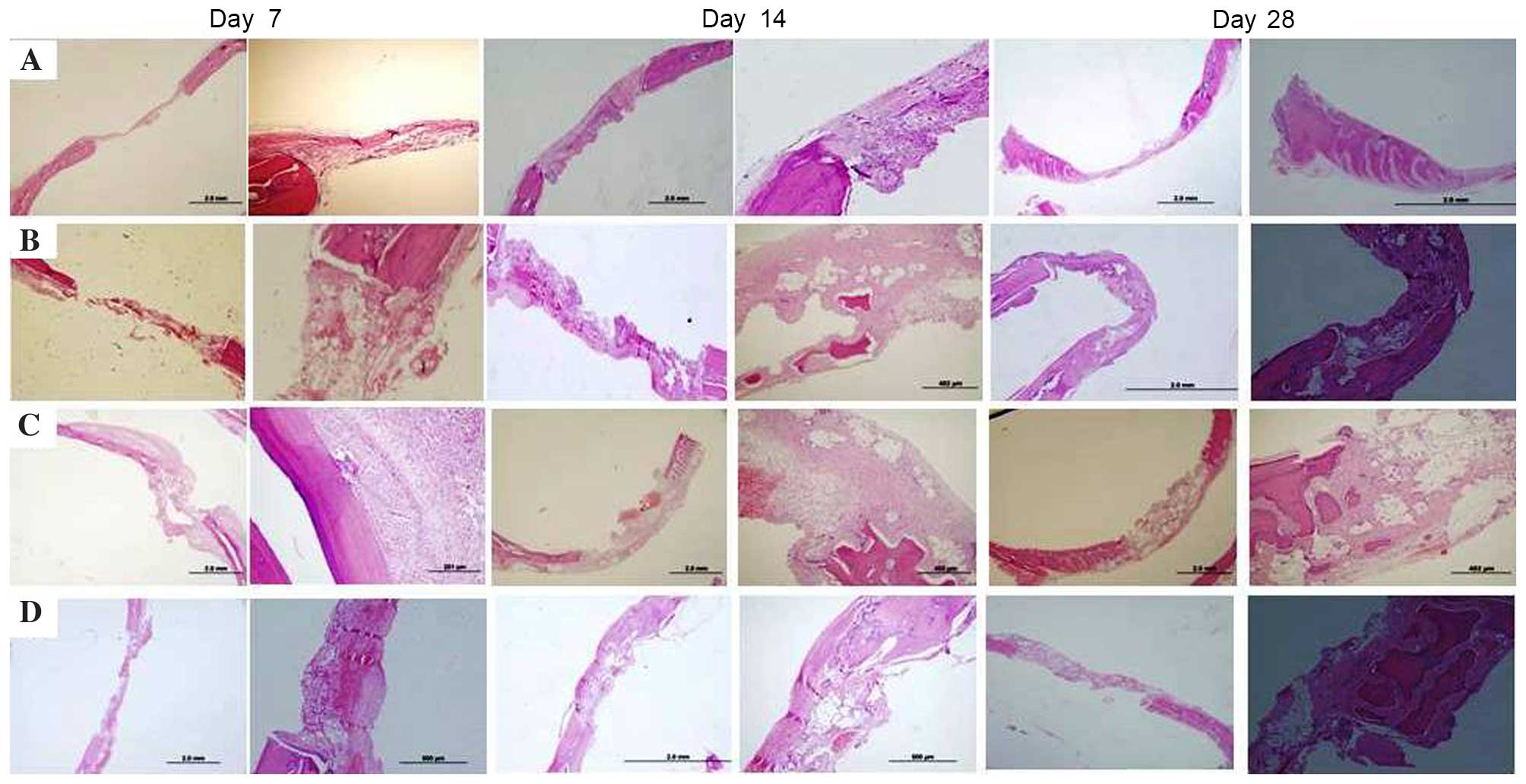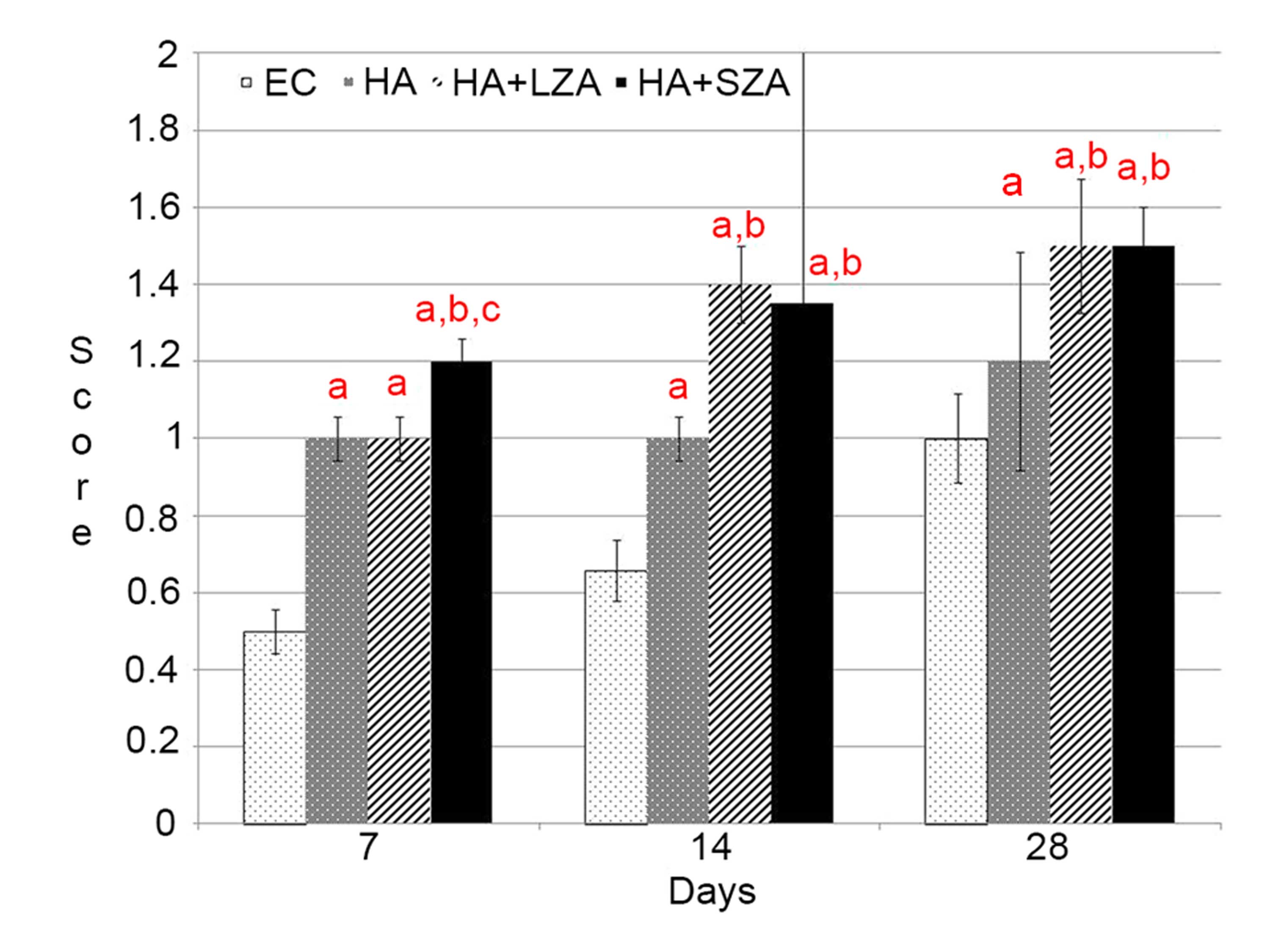|
1
|
Buser D, Brägger U, Lang NP and Nyman S:
Regeneration and enlargement of jaw bone using guided tissue
regeneration. Clin Oral Implants Res. 1:22–32. 1990. View Article : Google Scholar : PubMed/NCBI
|
|
2
|
Ezirganli S, Polat S, Baris E, Tatar I and
Celik HH: Comparative investigation of the effects of different
materials used with a titanium barrier on new bone formation. Clin
Oral Implants Res. 24:312–319. 2013. View Article : Google Scholar : PubMed/NCBI
|
|
3
|
Alam S, Ueki K, Nakagawa K, Marukawa K,
Hashiba Y, Yamamoto E, Sakulsak S and Iseki N: Statin-induced bone
morphogenetic protein (BMP) 2 expression during bone regeneration:
An immunohistochemical study. Oral Surg Oral Med Oral Pathol Oral
Radiol Endod. 107:22–29. 2009. View Article : Google Scholar : PubMed/NCBI
|
|
4
|
Toker H, Ozdemir H, Ozer H and Eren K: A
comparative evaluation of the systemic and local alendronate
treatment in synthetic bone graft: A histologic and
histomorphometric study in a rat calvarial defect model. Oral Surg
Oral Med Oral Pathol Oral Radiol. 114(5 Suppl): S146–S152. 2012.
View Article : Google Scholar : PubMed/NCBI
|
|
5
|
Toker H, Ozdemir H, Ozer H and Eren K:
Alendronate enhances osseous healing in a rat calvarial defect
model. Arch Oral Biol. 57:1545–1550. 2012. View Article : Google Scholar : PubMed/NCBI
|
|
6
|
Fellah BH, Gauthier O, Weiss P, Chappard D
and Layrolle P: Osteogenicity of biphasic calcium phosphate
ceramics and bone autograft in a goat model. Biomaterials.
29:1177–1788. 2008. View Article : Google Scholar : PubMed/NCBI
|
|
7
|
Mah J, Hung J, Wang J and Salih E: The
efficacy of various alloplastic bone grafts on the healing of rat
calvarial defects. Eur J Orthod. 26:475–482. 2004. View Article : Google Scholar : PubMed/NCBI
|
|
8
|
Doggrell SA: Clinical efficacy and safety
of zoledronic acid in prostate and breast cancer. Expert Rev
Anticancer Ther. 9:1211–1218. 2009. View Article : Google Scholar : PubMed/NCBI
|
|
9
|
Lipton A: The safety of zoledronic acid.
Expert Opin Drug Saf. 6:305–313. 2007. View Article : Google Scholar : PubMed/NCBI
|
|
10
|
Jakobsen T, Baas J, Kold S, Bechtold JE,
Elmengaard B and Søballe K: Local bisphosphonate treatment
increases fixation of hydroxyapatite-coated implants inserted with
bone compaction. J Orthop Res. 27:189–194. 2009. View Article : Google Scholar : PubMed/NCBI
|
|
11
|
Jakobsen T, Baas J, Bechtold JE,
Elmengaard B and Søballe K: Soaking morselized allograft in
bisphosphonate can impair implant fixation. Clin Orthop Relat Res.
463:195–201. 2007.PubMed/NCBI
|
|
12
|
Ayan M, Dolanmaz D, Mihmanli A, Ayan A and
Kürkcü M: The effect of systemically administrated zoledronic acid
on the osseointegration of dental implants. Oral Dis. 18:802–808.
2012. View Article : Google Scholar : PubMed/NCBI
|
|
13
|
Ruggiero SL: Bisphosphonate-related
osteonecrosis of the jaw (BRONJ): Initial discovery and subsequent
development. J Oral Maxillofac Surg. 67(5 Suppl): S13–S18. 2009.
View Article : Google Scholar
|
|
14
|
Ruggiero SL, Mehrotra B, Rosenberg TJ and
Engroff SL: Osteonecrosis of the jaws associated with the use of
bisphosphonates: A review of 63 cases. J Oral Maxillofac Surg.
62:527–534. 2004. View Article : Google Scholar : PubMed/NCBI
|
|
15
|
Yaman F, Atilgan S, Günes N, Agacayak S,
Günay A, Ucan MC, Bakir S, Erol B, Kose I and Atalay Y:
Phosphodiesterase-5 inhibitors may facilitate bone defect recovery.
Eur Rev Med Pharmacol Sci. 15:1301–1305. 2011.PubMed/NCBI
|
|
16
|
Ozdemir H, Ezirganli S, Isa Kara M,
Mihmanli A and Baris E: Effects of platelet rich fibrin alone used
with rigid titanium barrier. Arch Oral Biol. 58:537–544. 2013.
View Article : Google Scholar : PubMed/NCBI
|
|
17
|
Walsh JP, Ward LC, Stewart GO, Will RK,
Criddle RA, Prince RL, Stuckey BG, Dhaliwal SS, Bhagat CI,
Retallack RW, et al: A randomized clinical trial comparing oral
alendronate and intravenous pamidronate for the treatment of
Paget's disease of bone. Bone. 34:747–754. 2004. View Article : Google Scholar : PubMed/NCBI
|
|
18
|
Wellington K and Goa KL: Zoledronic acid:
A review of its use in the management of bone metastases and
hypercalcaemia of malignancy. Drugs. 63:417–437. 2003. View Article : Google Scholar : PubMed/NCBI
|
|
19
|
Rodan GA and Fleisch HA: Bisphosphonates:
Mechanisms of action. J Clin Invest. 97:2692–2696. 1996. View Article : Google Scholar : PubMed/NCBI
|
|
20
|
Altundal H and Gursoy B: The influence of
alendronate on bone formation after autogenous free bone grafting
in rats. Oral Surg Oral Med Oral Pathol Oral Radiol Endod.
99:285–291. 2005. View Article : Google Scholar : PubMed/NCBI
|
|
21
|
Menezes AM, Rocha FA, Chaves HV, Carvalho
CB, Ribeiro RA and Brito GA: Effect of sodium alendronate on
alveolar bone resorption in experimental periodontitis in rats. J
Periodontol. 76:1901–1909. 2005. View Article : Google Scholar : PubMed/NCBI
|
|
22
|
Coxon FP, Thompson K and Rogers MJ: Recent
advances in understanding the mechanism of action of
bisphosphonates. Curr Opin Pharmacol. 6:307–312. 2006. View Article : Google Scholar : PubMed/NCBI
|
|
23
|
von Knoch F, Jaquiery C, Kowalsky M,
Schaeren S, Alabre C, Martin I, Rubash HE and Shanbhag AS: Effects
of bisphosphonates on proliferation and osteoblast differentiation
of human bone marrow stromal cells. Biomaterials. 26:6941–6949.
2005. View Article : Google Scholar : PubMed/NCBI
|
|
24
|
Kaynak D, Meffert R, Günhan M, Günhan O
and Ozkaya O: A histopathological investigation on the effects of
the bisphosphonate alendronate on resorptive phase following
mucoperiosteal flap surgery in the mandible of rats. J Periodontol.
71:790–796. 2000. View Article : Google Scholar : PubMed/NCBI
|
|
25
|
Idris AI, Rojas J, Greig IR, Van'tHof RJ
and Ralston SH: Aminobisphosphonates cause osteoblast apoptosis and
inhibit bone nodule formation in vitro. Calcif Tissue Int.
82:191–201. 2008. View Article : Google Scholar : PubMed/NCBI
|
|
26
|
Myoung H, Park JY and Choung PH: Effects
of a bisphosphonate on the expression of bone specific genes after
autogenous free bone grafting in rats. J Periodontal Res.
36:244–251. 2001. View Article : Google Scholar : PubMed/NCBI
|
|
27
|
Xue QY, Ji Q, Li HS, Zou XN, Egund N, Lind
M, Christensen FB and Bünger C: Alendronate treatment does not
inhibit bone formation within biphasic calcium phosphate ceramics
in posterolateral spinal fusion: An experimental study in porcine
model. Chin Med J (Engl). 122:2770–2774. 2009.PubMed/NCBI
|
|
28
|
Srisubut S, Teerakapong A, Vattraphodes T
and Taweechaisupapong S: Effect of local delivery of alendronate on
bone formation in bioactive glass grafting in rats. Oral Surg Oral
Med Oral Pathol Oral Radiol Endod. 104:e11–e16. 2007. View Article : Google Scholar : PubMed/NCBI
|
|
29
|
Pampu AA, Dolanmaz D, Tüz HH and
Karabacakoglu A: Experimental evaluation of the effects of
zoledronic acid on regenerate bone formation and osteoporosis in
mandibular distraction osteogenesis. J Oral Maxillofac Surg.
64:1232–1236. 2006. View Article : Google Scholar : PubMed/NCBI
|
|
30
|
Yildiz A, Esen E, Kürkcü M, Damlar I,
Dağlioğlu K and Akova T: Effect of zoledronic acid on
osseointegration of titanium implants: An experimental study in an
ovariectomized rabbit model. J Oral Maxillofac Surg. 68:515–523.
2010. View Article : Google Scholar : PubMed/NCBI
|
|
31
|
Tatli U, Ustün Y, Kürkcü M, Erdoğan O,
Gürbüz CC, Ozgür H and Polat S: Effects of zoledronic acid on
healing of mandibular fractures: An experimental study in rabbits.
J Oral Maxillofac Surg. 69:1726–1735. 2011. View Article : Google Scholar : PubMed/NCBI
|
|
32
|
Chen T, Berenson J, Vescio R, Swift R,
Gilchick A, Goodin S, LoRusso P, Ma P, Ravera C, Deckert F, et al:
Pharmacokinetics and pharmacodynamics of zoledronic acid in cancer
patients with bone metastases. J Clin Pharmacol. 42:1228–1236.
2002. View Article : Google Scholar : PubMed/NCBI
|


















